Slack vs. GroupMe: Which Messaging App Is Right for You?
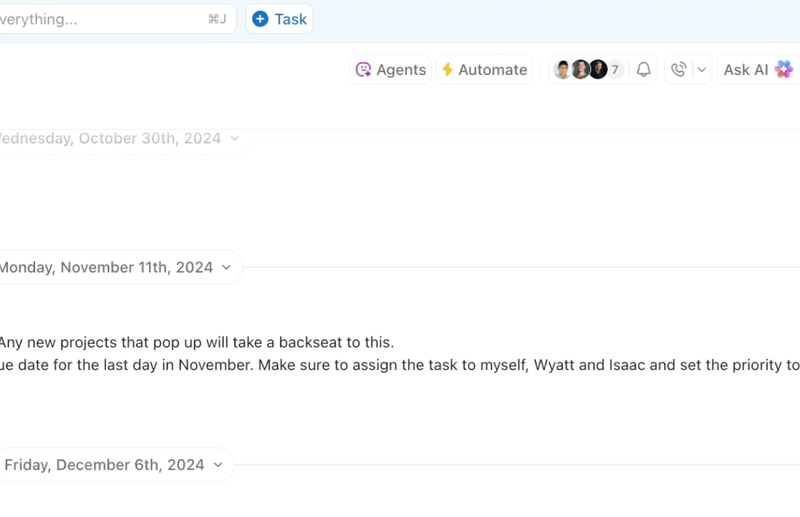
Sorry, there were no results found for “”
Sorry, there were no results found for “”
Sorry, there were no results found for “”

Whether you’re leading a project, managing a team, or just trying to keep group chats from turning into chaos, the right messaging app makes a real difference.
Good news—there’s no shortage of great options to increase productivity and keep you connected, organized, and working smarter (not harder).
That said, not every messaging or communication tool offers the same mix of features, and honestly, you might not even need all the bells and whistles.
Still, two names pop up repeatedly when teams and students discuss staying connected: Slack and GroupMe.
We’re breaking them down side-by-side to help you determine which fits your workflow best.
| Feature | Slack | GroupMe |
| Integrations | 2,000+ app integrations (Google Drive, Trello, etc.) | No major app integrations |
| Project management | Built-in task lists, collaborative docs (Canvas) | No task management tools |
| Voice/Video calls | Huddles, integrations with Zoom and Teams | Video calls via Microsoft Teams only |
| Access | Desktop, mobile, web; guest access supported | Mobile, web; SMS support (U.S. only) |
| User limit | No hard limit; suitable for large organizations | Up to 10,000 members per group |
And just when you think you’ve seen it all, we have a bonus pick that could completely change how you work and chat. Try ClickUp instead

Slack is a messaging app for teams. It lets people talk in real time, one-on-one or in groups. You can create channels for different topics, projects, or departments.
It also lets you share files, tag teammates, and connect tools like Google Drive or Zoom. You can start voice or video calls without leaving the app.
Slack aims to keep work conversations in one place so you don’t have to rely on long email threads or scattered messages.
📖 Also Read: Best Slack Competitors
Slack offers features that make team communication clear, organized, and easy to manage. Here’s a look at what it provides:

Channels group conversations by team, project, or topic. Each channel is a dedicated space where related messages, files, and tools live together.
Public channels keep information open to anyone in the company, while private channels restrict access to specific members. This setup makes it easier for teams to stay on track and for new members to catch up quickly.

Direct messages allow private conversations between two or more people. They are useful for quick updates, side conversations, or sensitive discussions.
Users can create group DMs for smaller teams working closely together without needing a whole channel. Everything stays organized and easy to access later.
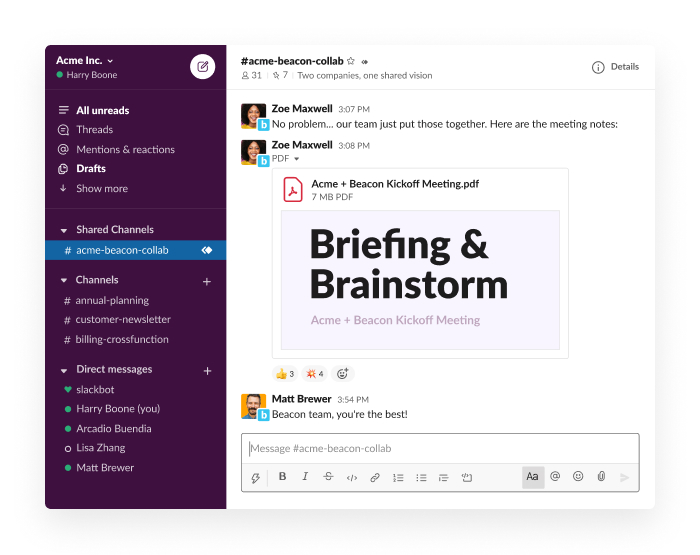
Slack makes it easy to upload and share documents, spreadsheets, images, PDFs, and videos directly into a conversation. Files shared in a channel or DM stay connected to the message history.
Users can search for files later by keyword, file type, or who shared them, making it easy to find essential materials without digging through multiple apps.
📖 Also Read: Slack Hacks to Improve Workplace Communication
Slack connects with thousands of apps like Google Drive, Zoom, Trello, Asana, and Salesforce. These integrations directly bring notifications, project updates, and new tasks into Slack.
Teams can take action on many tasks—such as approving a document or joining a meeting—without switching between different platforms. It saves time and keeps workflows moving inside one workspace.

Slack Huddles offer lightweight voice and video chats that can start instantly from any channel or DM. They work well for quick check-ins, solving problems faster, or brainstorming ideas without setting up a formal meeting.
Huddles also support screen sharing, letting team members show their work in real-time and collaborate on the spot.
Slack AI offers powerful search and summarization functionalities in Slack’s paid plans. Users can ask questions in natural language and receive concise answers with citations from their team’s conversation history, making it easier to find information and get up to speed on projects.
The platform can automatically generate summaries of channels and long threads, providing a quick overview of discussions without reading through every message.
📖 Also Read: How to Use Slack for Project Management
👀 Did You Know?
Studies reveal that loneliness is becoming a major factor affecting employee engagement and performance—and it’s now recognized as a real business risk. A big part of the problem? Teams relying solely on email and chat apps that scatter conversations and limit meaningful interaction. That’s why choosing the right communication tool matters. The more connected your team feels, the better they collaborate, support each other, and stay engaged.
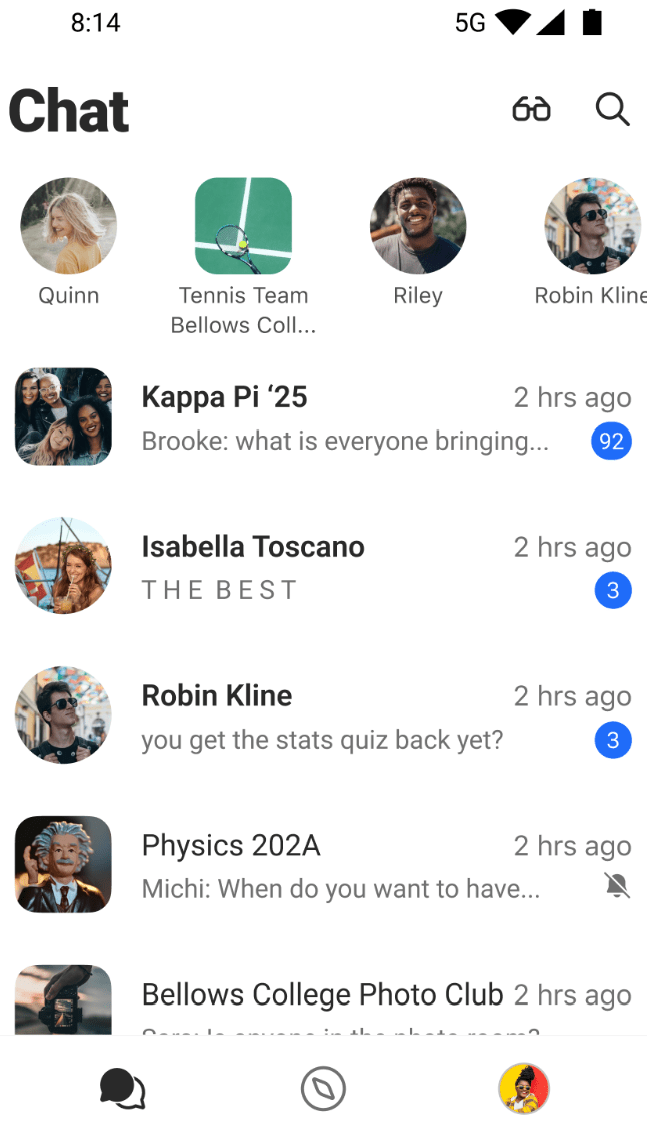
GroupMe is a Microsoft-owned chat tool for casual group chats. It lets people send texts, images, videos, and GIFs in private groups. You can also send direct messages for one-on-one conversations.
It works over Wi-Fi, mobile data, or even SMS. People without the app can still join and chat through regular text messages.
GroupMe focuses on keeping group communication simple. It’s built for students, friends, families, clubs, and small teams who want an easy way to stay in touch without extra features.
📖 Also Read: Top Asynchronous Communication Tools
GroupMe keeps group communication simple and easy to use. Here’s a look at what it offers:
You can create private groups for friends, family, clubs, or teams. Each group acts as its own chat room where people can send texts, share media, and react to messages.
There’s no limit to how many groups you can create, so you can keep different parts of your life separate.

GroupMe lets you send private messages to individuals. It’s useful when you need to have a quick side conversation or share something you don’t want the whole group to see.
Direct messages work just like group chats, but stay between you and one other person.
GroupMe works even if someone doesn’t have the app. People can join and chat through regular text messaging.
This makes it easier to include everyone, whether they have a smartphone, a basic phone, or just prefer using SMS.
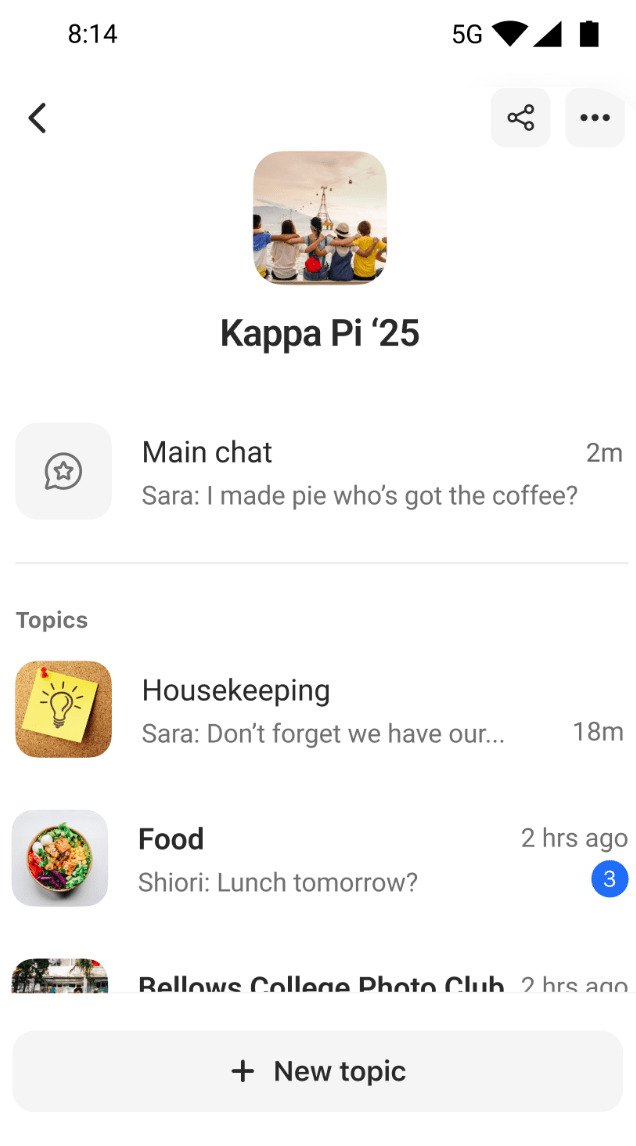
You can send photos, videos, and GIFs directly into any chat or create polls to get everyone’s thoughts on plans quickly. Media shows up in the conversation, making it easy to share moments, updates, or event details.
Everything stays linked to the chat history, so you can scroll back and find shared files when needed.
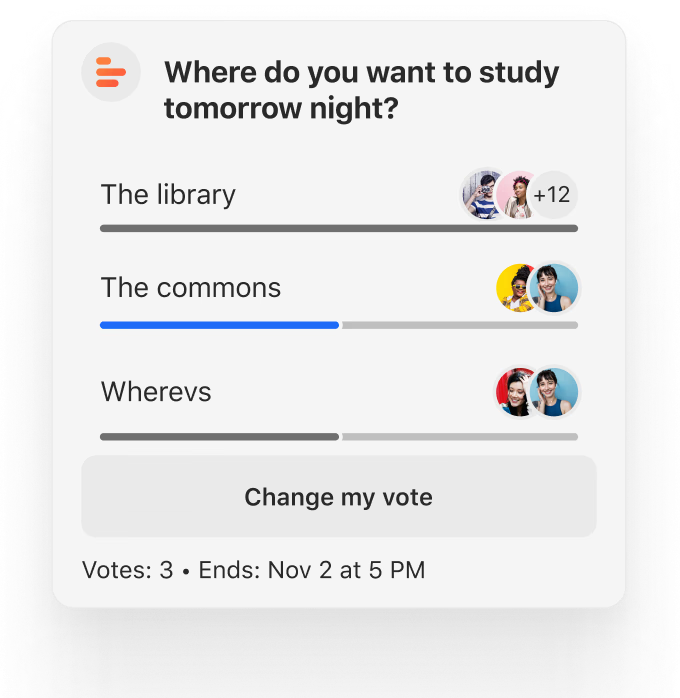
GroupMe gives you control over your notifications. You can mute specific groups, turn off alerts during busy hours, or customize sounds for different chats.
It helps you stay connected without feeling overwhelmed by constant pings.
GroupMe is free to use. You can download the app on iOS, Android, or use it on the web without any subscription fees. Standard text messaging rates from your carrier may apply if you’re using SMS to send or receive messages.
The app also offers optional in-app purchases, such as emoji packs, which range from $0.99 to $1.99. There are no premium tiers or paid upgrades—just the core features available to all users.
📖 Also Read: Free Project Communication Plan Templates
As we’ve seen, both Slack and GroupMe are messaging apps, but for unique purposes. Slack is built for workplace communication, with more tools for projects and collaboration. GroupMe focuses on simple group chats for casual use.
| Feature | Slack | GroupMe | Bonus: ClickUp |
| Messaging | Real-time messaging in channels and direct messages | Group chats and direct messages | Real-time chat, threaded comments on tasks and docs for contextual team discussions |
| Voice/video calls | Huddles for quick audio or video chats. Integrates with Zoom and Teams | One-on-one and group video calls through Microsoft Teams | Instant audio and video calls within chats; integrates with Zoom, Google Meet, and other video platforms |
| File sharing | Share documents, images, and other files directly in chats | Share photos, videos, and GIFs in group chats and DMs | Add files and mention tasks or people directly in chats; share supports Google Drive, Dropbox, and more integrations |
| AI features | Slack AI for chat search, thread summaries, and channel recaps; Agentforce integration | Microsoft Copilot for basic search functionalities | ClickUp Brain fully integrated in chat, tasks, docs, whiteboards, and more; AI agents for specific tasks and workflows |
| Integrations | Connects with 2,000+ apps like Google Drive, Trello, Salesforce | Limited to basic features with no major app integrations | 1,000+ integrations including Slack, Google Drive, GitHub, Zoom, and more |
| Project management | Built-in tools like Lists for tasks and Canvas for collaborative docs | Basic event planning within groups, no task management tools | Advanced task management, Docs, Whiteboards, Goals, Automations, and more |
| Customization | Customizable notifications, workflows, and themes | Customizable notifications and group settings; limited themes | Highly customizable workflows, statuses, views, automations, and dashboards |
| Access | Desktop, mobile, and web. Supports guest access for external users | Mobile and web. SMS support for users without smartphones (U.S. only) | Desktop, mobile, and web. Guest and public sharing options |
| User limit | No hard limit; works for small teams or large companies | Up to 10,000 members per group | No hard user limit; scalable for teams of all sizes |
| Cost | Free plan available; paid plans offer more features and app integrations | Free to use; no paid versions | Free plan available; paid plans unlock advanced features and integrations |
Now, let’s compare standard yet essential features of Slack and GroupMe in detail and see how they perform.
Slack is designed for work. It uses channels to organize conversations by team, project, or topic. It also supports threaded replies, so people can respond to specific messages without cluttering the main chat. Direct messages are available for private chats between individuals or small groups. You can search through all messages and files easily.
GroupMe is built for casual group chats. You create a group, invite people, and start chatting. Direct messages are also available for private conversations. GroupMe supports SMS, letting users join conversations even without downloading the app.
🏆 Winner: Slack
Both apps handle messaging well, but Slack offers more ways to keep conversations organized and easier to manage, especially when the number of messages grows.
Sharing files in Slack is like an extension of work. You can drop in a document, link a file from Google Drive, or share a video—all in the middle of a conversation.
Everything you send is stored with the chat, and search pulls it up when needed. That matters when teams rely on the same files repeatedly.
GroupMe sticks to the basics. You can send a photo, a quick video, or a meme. That’s it. It works well for casual updates—trip photos, event invites, music links—but not much more.
🏆 Winner: Slack
If you’re just having a casual conversation, GroupMe does the job. If files are part of how you get work done, Slack handles it better.
Slack offers Huddles—quick, informal calls that can be started from any channel or direct message. You can turn on video, share your screen, and invite others to join.
Huddles are designed for spontaneous conversations without the need to schedule a meeting. On free plans, Huddles are limited to two participants; paid plans allow up to 50 participants.
GroupMe integrates with Microsoft Teams for its calling feature. You can start a video call directly from a group chat or schedule one as part of an event. This setup is useful for larger, planned meetings. GroupMe supports calls with up to 100 participants.
🏆 Winner: Tie!
Both apps provide calling options, and you should choose what suits you. Slack’s Huddles are better suited for quick, impromptu discussions, while GroupMe’s integration with Teams is geared towards scheduled group meetings with a large number of participants.
📖 Also Read: How to Use Instant Messaging at Work
We browsed Reddit to see how people compare Slack and GroupMe. Across several threads, users shared clear reasons why one tool might work better than the other, especially when it comes to group communication.
Many users said Slack handles bigger or more organized groups more effectively.
Slack can display 16 lines of text, a picture, and a gfycat in the same space that GroupMe can only display two pictures and one line of text.
Users also praised how Slack keeps conversations separate:
Multiple channels per group, allowing us to have a channel for everything we need without making it tough to switch between channels. GroupMe merges all channels and chats together for every group.
That said, GroupMe still works well for simple communication.
GroupMe. Works for us.
Reddit users seem to agree: if your group needs structure and business-oriented features, Slack is the better fit. If you just want to keep in touch without much setup, GroupMe gets the job done.
Sure, Slack and GroupMe get the job done—but what if you need more than just messages and media?
Maybe you’re tired of jumping between apps just to track tasks, share updates, or keep conversations organized. Perhaps you want a tool where chat, docs, and deadlines actually work together. That’s where ClickUp comes in.
ClickUp is the everything app for work. It combines tasks, chats, docs, and goals into one place so your team can stay focused without switching tools. Whatever you use it for, ClickUp gives you everything you need in one view.
No clutter. No silos. Just one workspace where everything connects—messages lead to actions, docs support tasks, and goals stay visible. If Slack and GroupMe feel limited, ClickUp is the upgrade you didn’t know you needed.
📮 ClickUp Insight: 83% of knowledge workers depend on email and chat as their main forms of team communication. This often spreads important information across separate tools, making it harder for teams to stay aligned and work efficiently.
ClickUp brings everything into one place—threaded conversations, messages, comments, tasks, and docs—for easier team collaboration.
Let’s look at ClickUp’s key features that make it a better option over Slack and GroupMe.

ClickUp Chat brings your conversations and work together in one place.
Discuss a project in Chat, and with a single click, turn any message into a task. No more copying notes or losing context—everything stays linked and organized.
Need to catch up on a long thread? ClickUp’s AI can summarize discussions, highlight key points, and even suggest action items. It’s like having an assistant who keeps you informed without the clutter.
ClickUp Chat supports channels for team-wide discussions and direct messages for private conversations. You can also start voice or video calls directly from the chat, making real-time collaboration seamless.
By integrating chat with tasks, documents, and goals, ClickUp ensures that your communication is always connected to your work. It’s not just about chatting—it’s about getting things done.

ClickUp Assigned Comments make sure nothing gets lost in the shuffle. Instead of dropping a note and hoping someone follows up, you can assign any comment to a team member and turn it into a clear, trackable task.
The comment shows up in their work queue and stays there until it’s marked as resolved. That means no guessing, no reminders, and no missed details. Everyone knows what they need to do—and when.
Assigned Comments work across tasks, docs, and chats. So, whether you’re giving feedback on a document or calling something out in a thread, you can ensure it gets done.
It’s a simple way to keep work moving and conversations productive, especially when teams are juggling multiple priorities.

ClickUp Tasks are where work begins. Whether you’re tracking a quick fix or managing a large project, tasks let you assign owners, set deadlines, add context with Custom Fields, and outline every step of the process.
You can break big projects into subtasks, add checklists, and create dependencies to show what needs to happen first. Everything stays connected, so your team always knows what’s next.
Each task has space for comments, files, links, and updates. You don’t have to switch to other tools or dig through chats—everything lives in one place.
ClickUp Tasks give you control without adding complexity. It’s the foundation that keeps teams organized, aligned, and moving forward.
ClickUp Brain is a holistic AI assistant that permeates every aspect of your work within ClickUp. It’s designed not just to analyze existing work but to actively help create and manage it.
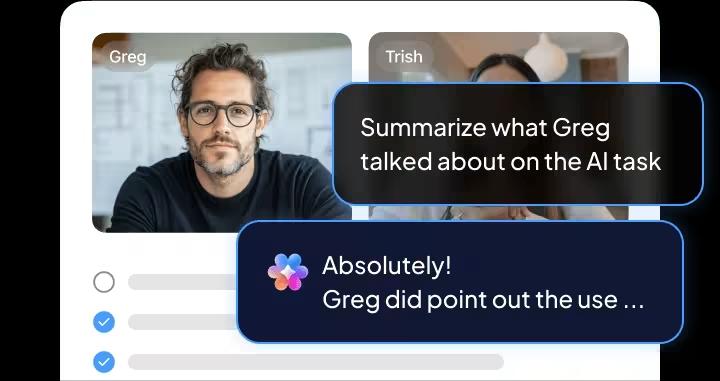
ClickUp Brain doesn’t just facilitate conversations; it actively helps you get work done. You can ask questions about projects, request summaries, or even create tasks directly from chat.
Need to find a document, update a task, or get a quick project status? Just ask ClickUp Brain in your chat, and it delivers instant, actionable answers from across your entire workspace—no more switching tabs or digging through threads.
Managing tasks is just as seamless with ClickUp Brain’s enterprise-level features. You can create, update, or find tasks using natural language—just type what you need.
Want to assign a task, set a due date, or check on progress? ClickUp Brain handles it in seconds, keeping your team aligned and projects moving forward. It even helps you prioritize work and spot blockers.
Attending a meeting? Let the ClickUp AI Notetaker record and transcribe it for you, with quick takeaways and suggested tasks to follow up.
What’s more, you can even use Autopilot Agents in ClickUp to find answers, create content, or automate repetitive and time-consuming workflows.
For teams used to juggling multiple tools like Slack, ClickUp Brain brings everything together, right where they need it. The result? Faster decisions, fewer mistakes, and a truly connected workflow.

With powerful built-in chat, real-time collaboration, and task-specific comments, ClickUp eliminates the need for a separate app like Slack. Instead of bouncing between specialized tools, teams can communicate, manage projects, and automate workflows—all in one place.
And if your team’s still using Slack, ClickUp integrates seamlessly with Slack, so you can gradually centralize your work without missing a beat. Think of it as your all-in-one work hub—chat included.
Slack and GroupMe both have their strengths, but if you’re looking for one tool with robust features to handle real-time chat, task management, docs, and more, ClickUp does it all.
It’s more than just messaging. It’s your team’s home base for organized, connected, and productive work.
Sign up for ClickUp’s Free Forever Plan and bring your conversations, projects, and goals together in one place.
© 2025 ClickUp